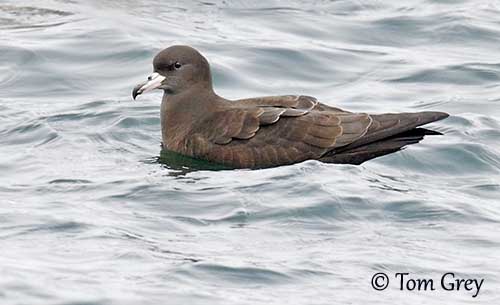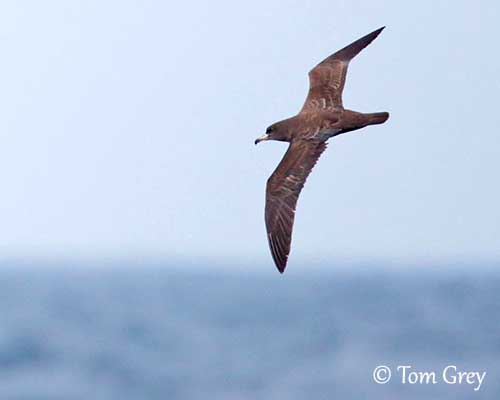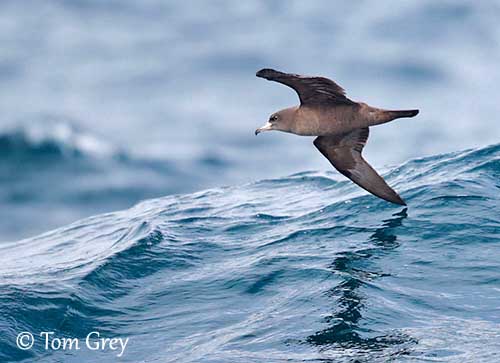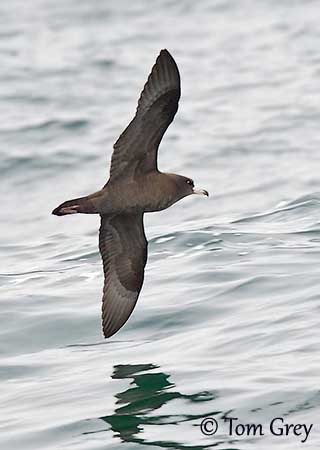
Fr: Puffin à pieds pâles
Ang: Flesh-footed Shearwater
All: Blassfuß-Sturmtaucher
Esp: Pardela Paticlara
Ita: Berta piedicarnicini
Nd: Australische Grote Pijlstormvogel
Sd: Ljusfotad lira
Photographer:
Tom Grey
Tom Grey's Bird Pictures
Text by Nicole Bouglouan
Sources:
HANDBOOK OF THE BIRDS OF THE WORLD vol 1 by Josep del Hoyo-Andrew Elliot-Jordi Sargatal - Lynx Edicions - ISBN: 8487334105
A Complete Guide to Antarctic Wildlife by Hadoram Shirihai and Illustrated by Brett Jarrett - Edited by Guy M. Kirwan - ALUL.A Press Oy, Finland - ISBN 9519894705
BirdLife International (BirdLife International)
Department of Sustainability, Environment, Water, Population and Communities
Bird Web (Seattle Audubon Society)
Birds in backyards (Birds Australia and Australian Museum)
What Bird-The ultimate Bird Guide (Mitchell Waite)
Wikipedia, the free encyclopaedia
Flesh-footed Shearwater
Ardenna carneipes
Procellariiformes Order – Procellariidae Family
INTRODUCTION:
The Flesh-footed Shearwater is a large, dark shearwater with pale bill, ranging throughout Pacific and Indian Oceans.
DESCRIPTION OF THE BIRD:
Biometrics:
Length: 41-48 cm
Wingspan: 99-116 cm
Weight: 535-765 g
The Flesh-footed Shearwater is a large, rather broad-winged shearwater. It has dark blackish-brown plumage overall, often darker on head, upper side of flight-feathers and uppertail. Mantle to uppertail-coverts has pale-edged feathers, involving scaly effect, and mainly on scapulars.
The underwing, and especially the flight-feathers and the greater coverts, are slightly paler and greyer. The belly is slightly paler than the upperparts, and may appear obscurely spotted.
The robust bill is pale pink or pale horn with blackish tip. The eyes are blackish. Legs and webbed feet are pale pink.
Both adults are similar, but the female is often slightly smaller than the male.
The juvenile resembles adults.

RANGE:
The Flesh-footed Shearwater breeds from September to April in southern oceans (Indian and Pacific) and SW Australia (only one single colony), Lord Howe Island off E Australia, and in New Zealand, on several islands in Cook Strait.
It winters from May to September north to N Pacific and N Indian Ocean.
HABITAT:
The Flesh-footed Shearwater is pelagic away from the breeding colonies. Its inhabits the open ocean, preferring to keep warm waters, but not commonly venturing as far north as many other shearwater species. It breeds on islands where it can dig burrows, on hills covered with vegetation and grassy slopes facing sea.
CALLS AND SONGS: SOUNDS BY XENO-CANTO
The Flesh-footed Shearwater is silent at sea. At colony, it utters series of high-pitched moans, resembling the sound given by fighting cats “gug-gug-gug” and “ku-koo-ah”. It is noisy mainly at night, within the burrow, or on the ground and also in flight.

BEHAVIOUR IN THE WILD:
The Flesh-footed Shearwater feeds primarily on squid and crustaceans.
It rarely comes close to the boats, but it may follow commercial fishing vessels, and will dive after offal thrown overboard. It often forages with flocks of smaller shearwaters.
It performs shallow dives into shoals, but it may dive occasionally at depths of 5 metres or more. It also scavenges from around whales and dolphins. The preys are also caught by surface-seizing, contact-dipping and pursuit-plunging. It feeds mainly during the daylight.
During the breeding season, they are active mainly at night. They call from the burrow entrances and while flying above the colonies. The breeding success depends on weather and oceanic conditions, as the currents bring fish to seas near the colonies.
During the nesting period, the Flesh-footed Shearwater digs a burrow into the soil. It is situated from sea level to up to 500 metres in vegetated slopes, having a tunnel of 2 to 3 metres of length, and ending in a broad chamber. Observations report that they go in and go out of the nest only at night.
The Flesh-footed Shearwater is migratory and moves northwards after breeding. They move first north towards W Indonesia, and then, they migrate W across the Indian Ocean.
It has a rather slow and ponderous flight, with slow, deep wingbeats, and long glides on stiff wings. In windier conditions, it shows more typical shearwater flight of long arcs.

REPRODUCTION OF THIS SPECIES:
The breeding season occurs between September/October and April/May, with egg-laying in late November/early December.
The Flesh-footed Shearwater breeds in dense colonies. It nests on islands off the coasts of SW and E Australia and New Zealand. It is active mostly at night. It digs an underground burrow of about 2-3 metres long or more.
The female lays a single white egg in December. The incubation lasts about 53 days, shared by both parents. At hatching, the chick has brown-grey down. It is fed by both adults. It fledges about 92 days after hatching. As pelagic birds, they leave the island in April or May and reach the ocean.
PROTECTION / THREATS / STATUS:
The Flesh-footed Shearwater’s population was estimated in 2004 at about 650,000 individuals. However, this species is affected by disturbance and destruction of coastal sites and can be killed while taking baits from fishing lines. Predation by rats, cats, and some other mammalian predators is still a threat. It is less widespread in New Zealand than previously.
Creation of reserves with restricted human access would be a good way to protect this species which is currently evaluated as Least Concern.
